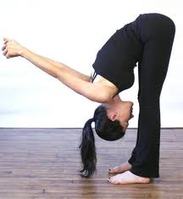 Yoga and Flexibility: According to Michael Alter, author of Science of Flexibility (Human Kinetics, 1998), current research demonstrates that individual muscle fibers can be stretched to approximately 150 percent of their resting length before tearing. This extendibility enables muscles to move through a wide range of motion, sufficient for most stretches—even the most difficult asanas. If your muscle fibers don't limit your ability to stretch, what does? There are two major schools of scientific thought on what actually most limits flexibility and what should be done to improve it. The first school focuses not on stretching muscle fiber itself but on increasing the elasticity of connective tissues, the cells that bind muscle fibers together, encapsulate them, and network them with other organs; the second addresses the "stretch reflex" and other functions of the autonomic (involuntary) nervous system. (Yoga works on both. That's why it's such an effective method for increasing flexibility)!!! Why is not recommended to bounce while we work in flexibility: The Stretch Reflex According to physiologists who view the nervous system as the major obstacle to increased flexibility, the key to overcoming one's limitations lies in another built-in feature of our neurology: the stretch reflex. Scientists who study flexibility think that the small, progressive steps that allow us to go a little deeper during the course of one session—and that dramatically improve our flexibility over a life of yoga practice—are in large part the result of retraining this reflex. To get an understanding of the stretch reflex, picture yourself walking in a winter landscape. Suddenly you step on a patch of ice, and your feet start to splay apart. Immediately your muscles fire into action, tensing to draw your legs back together and regain control. What just happened in your nerves and muscles? Every muscle fiber has a network of sensors called muscle spindles. They run perpendicular to the muscle fibers, sensing how far and fast the fibers are elongating. As muscle fibers extend, stress on these muscle spindles increases. When this stress comes too fast, or goes too far, muscle spindles fire an urgent neurological "SOS," activating a reflex loop that triggers an immediate, protective contraction. That's what happens when the doctor thumps with a small rubber mallet on the tendon just below your kneecap, stretching your quadriceps abruptly. This rapid stretch stimulates the muscle spindles in your quadriceps, signaling the spinal cord. An instant later the neurological loop ends with a brief contraction of your quadriceps, producing the well known "knee jerk reaction." That's how the stretch reflex protects your muscles. And that's why most experts caution against bouncing while stretching. Bouncing in and out of a stretch causes the rapid stimulation of muscle spindles that triggers reflexive tightening, and can increase your chances of injury.
0 Comments
Your comment will be posted after it is approved.
Leave a Reply. |
Claudia Gutierrez
Physical Therapist Yoga Teacher Fitness Instructor Life Coach Dreamer... [email protected] Categories
All
Yoga Fitness BlogI am Claudia Gutierrez, owner of Yoga Fitness, originally from Argentina and proudly Irish Citizen since 2012. Archives
November 2021
|

 RSS Feed
RSS Feed
